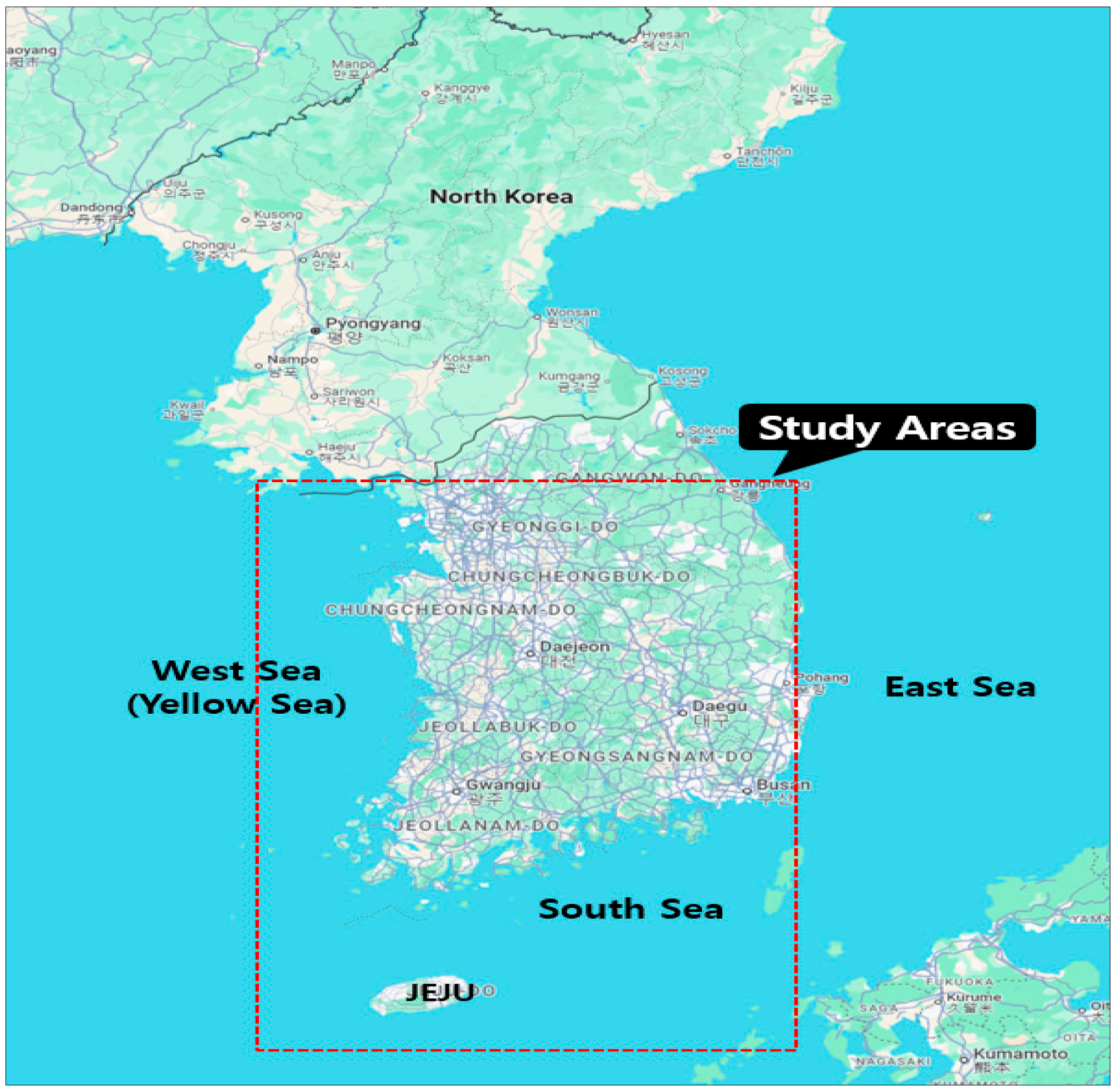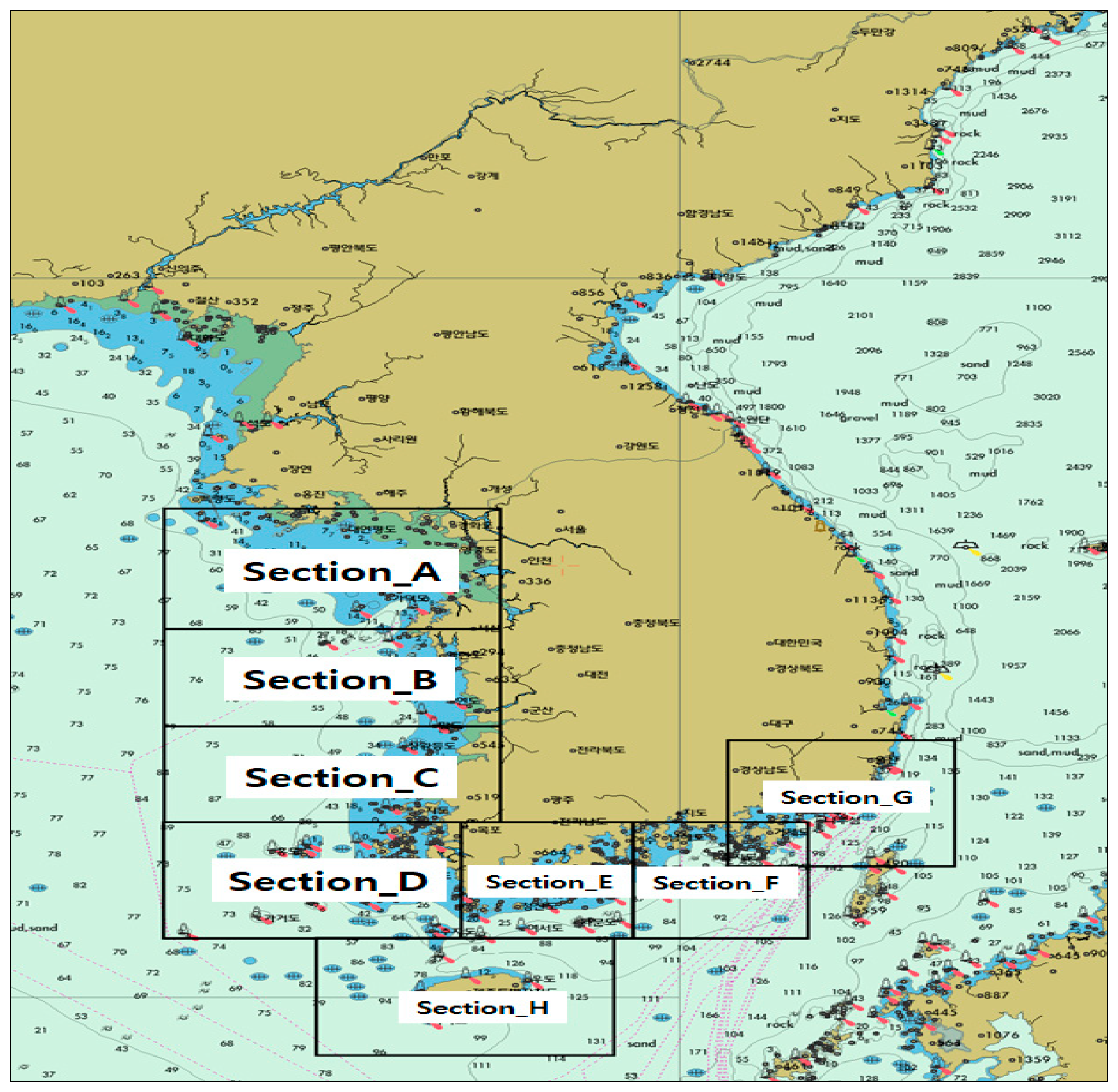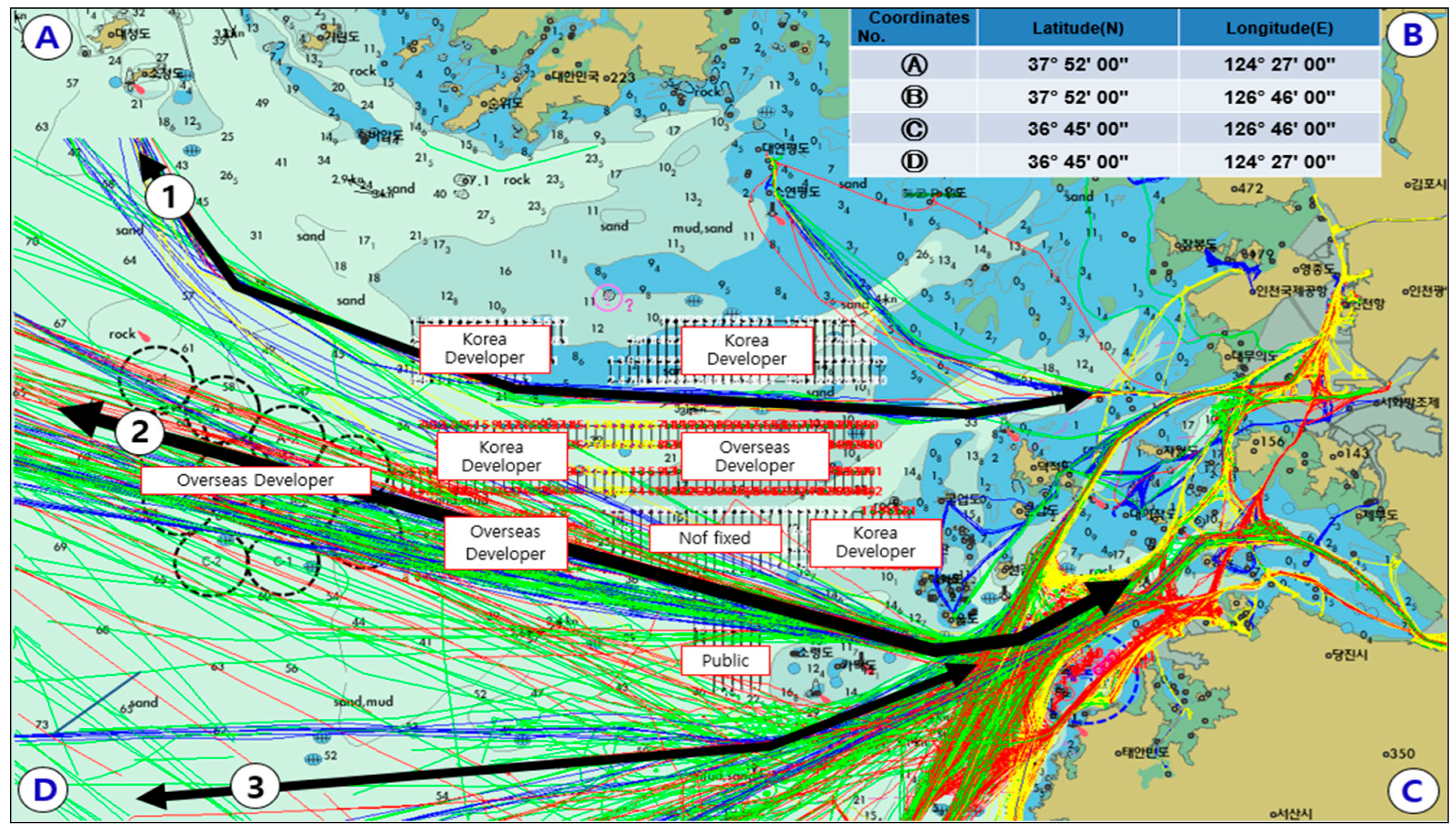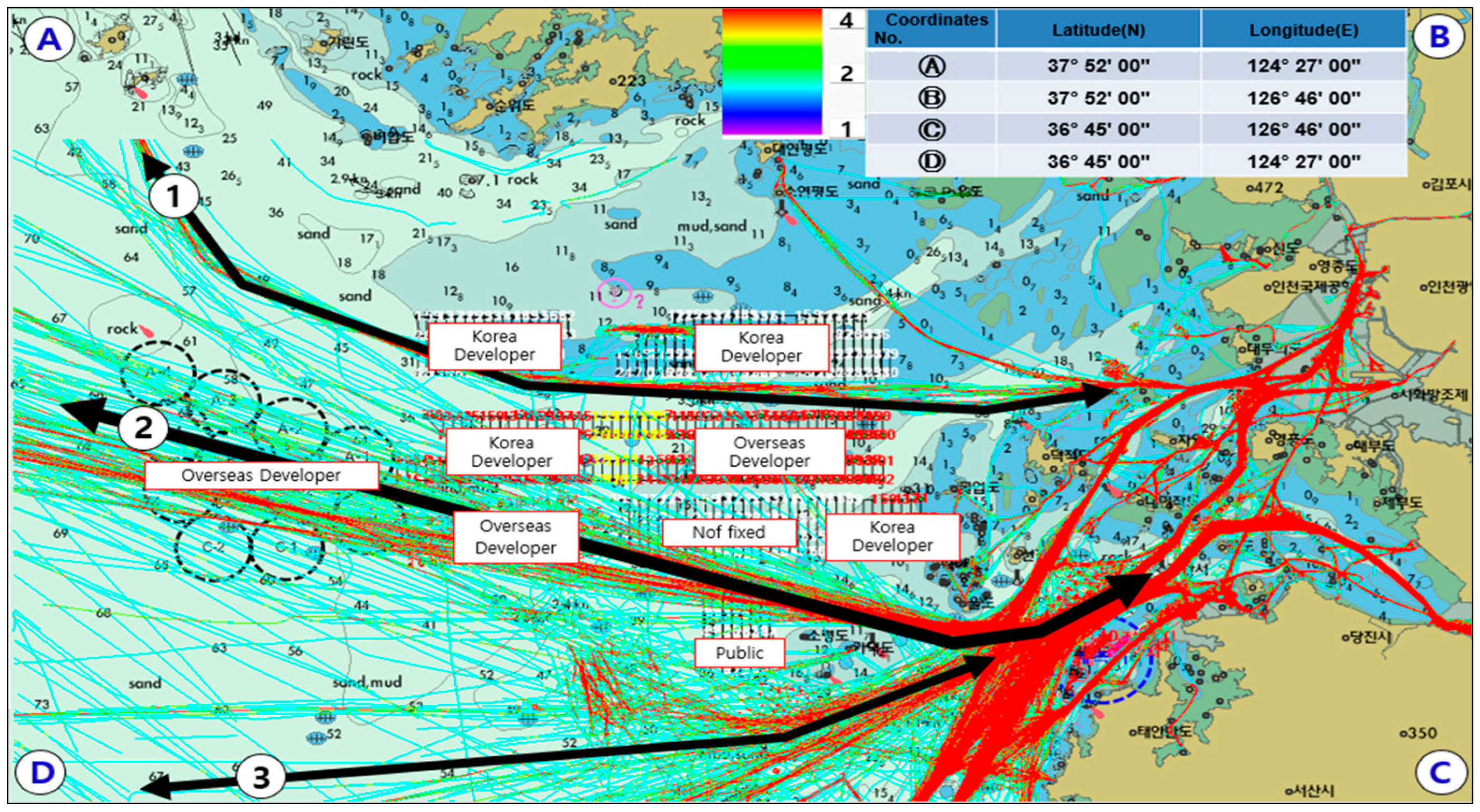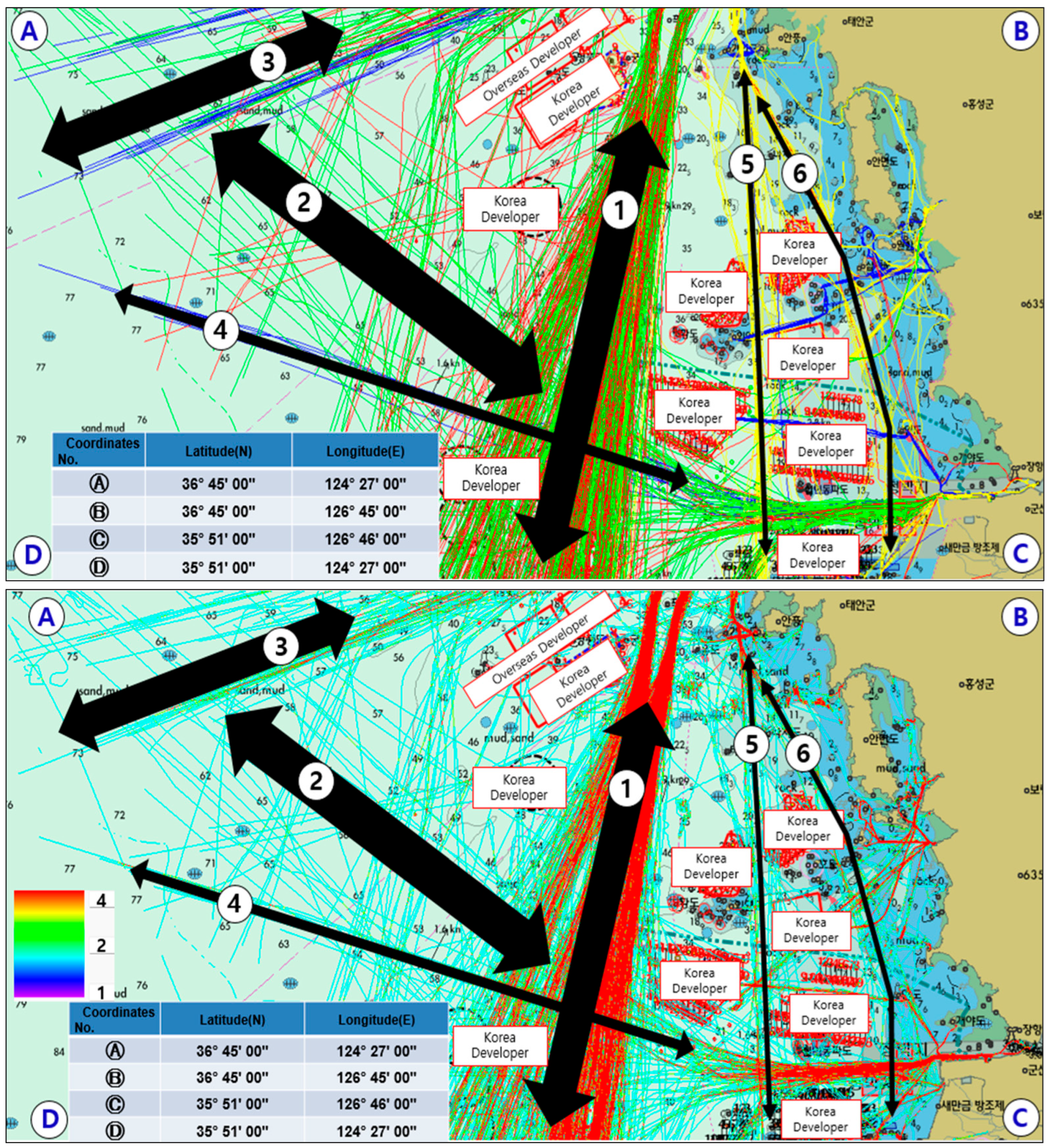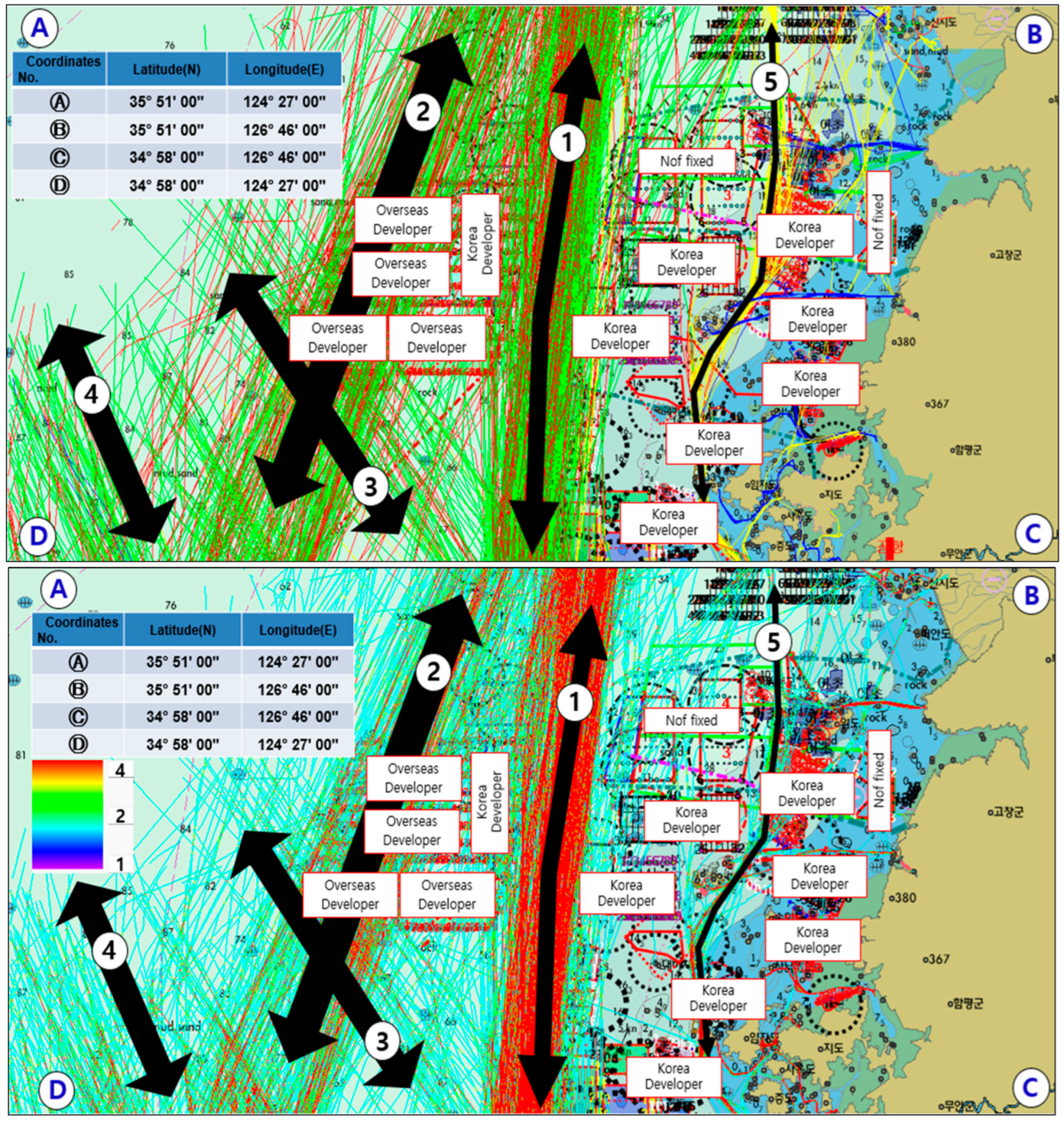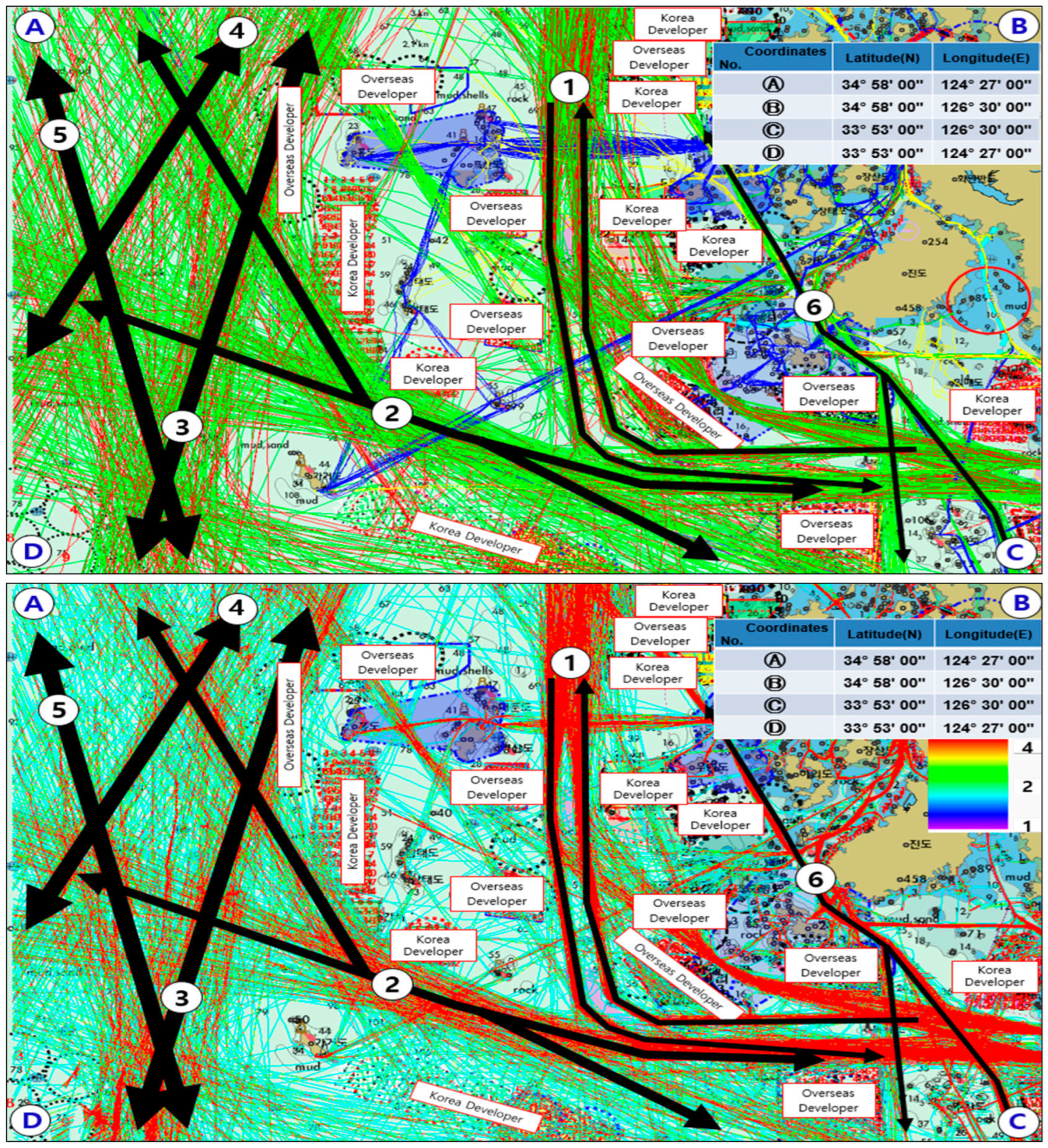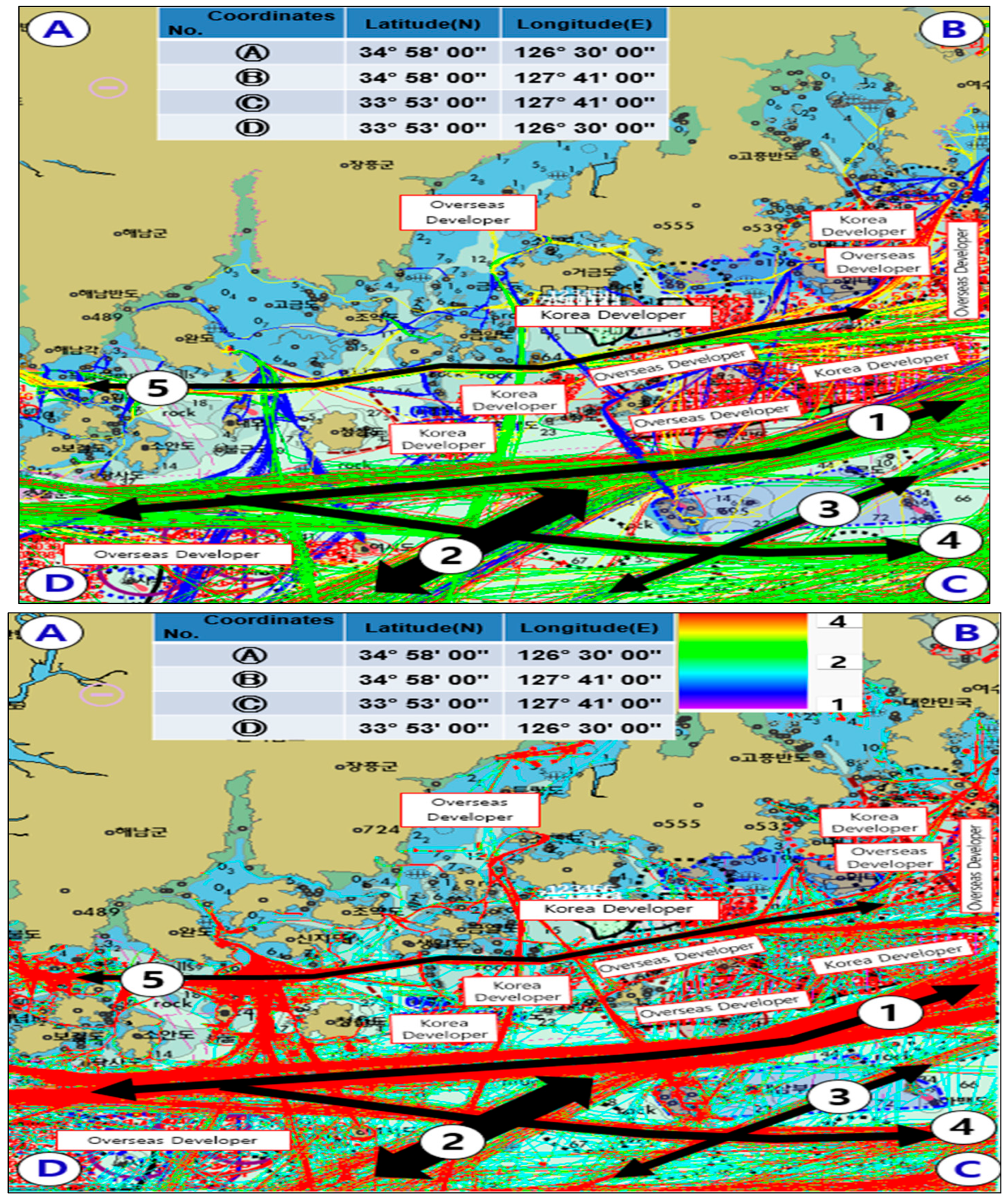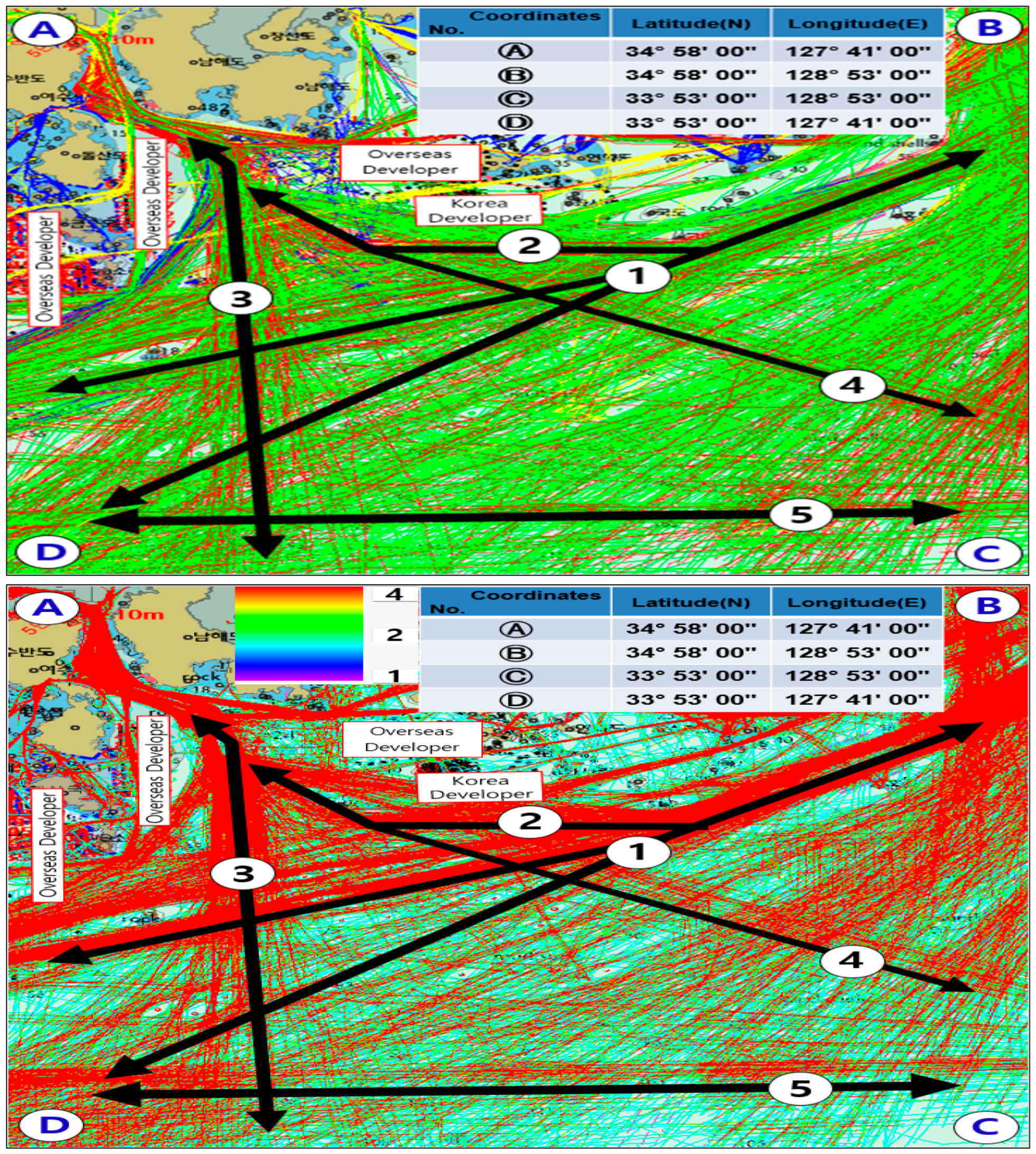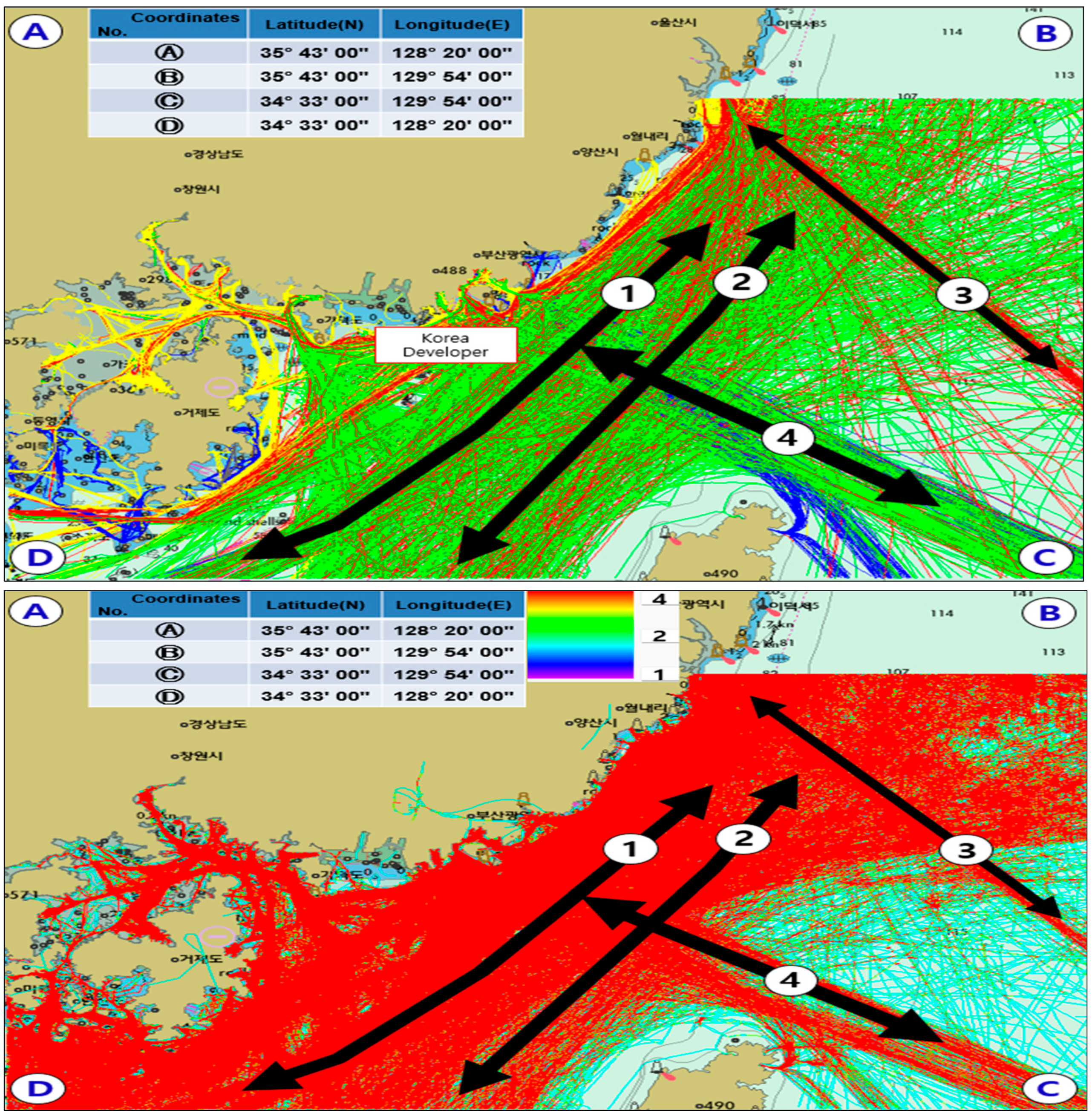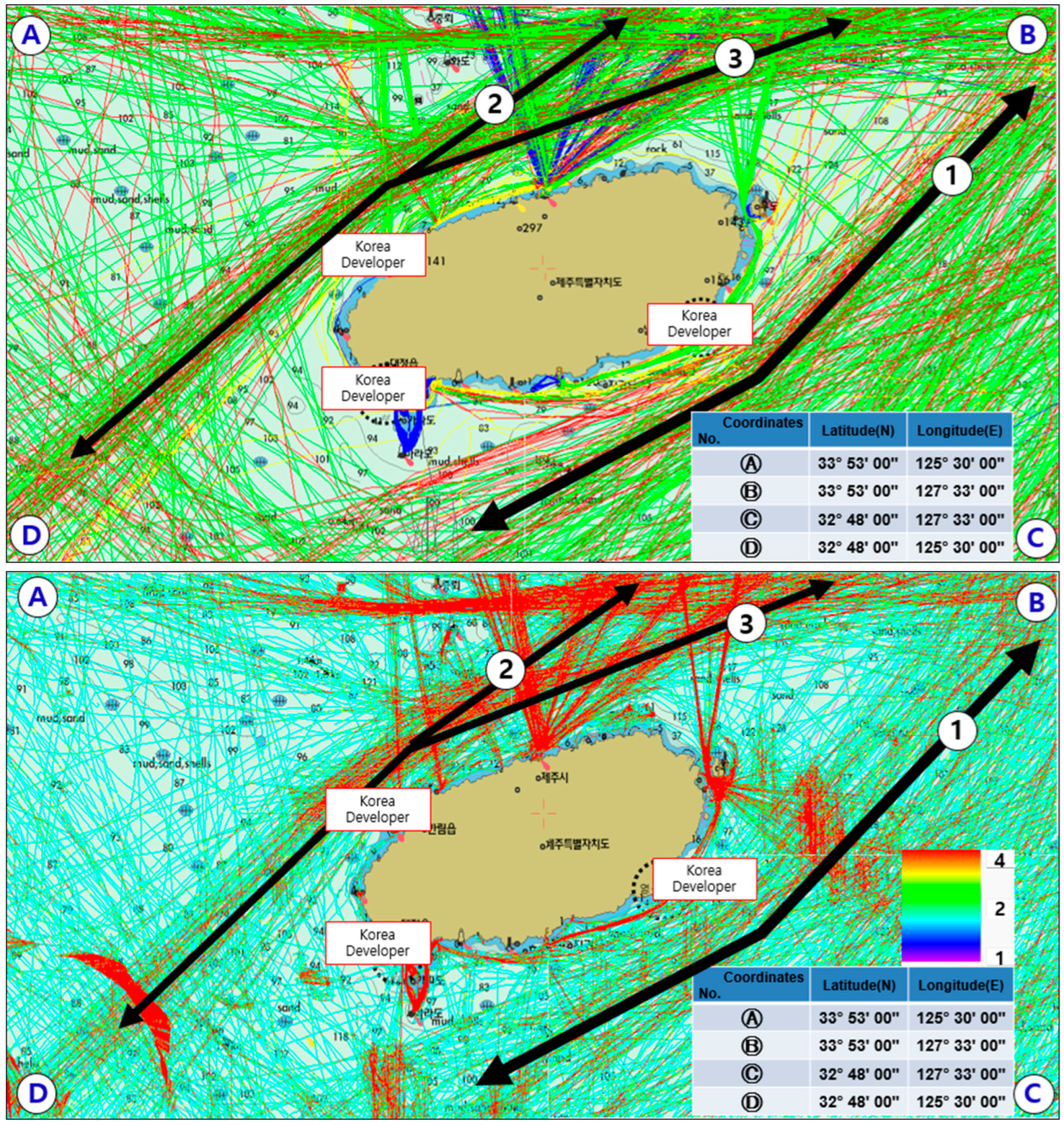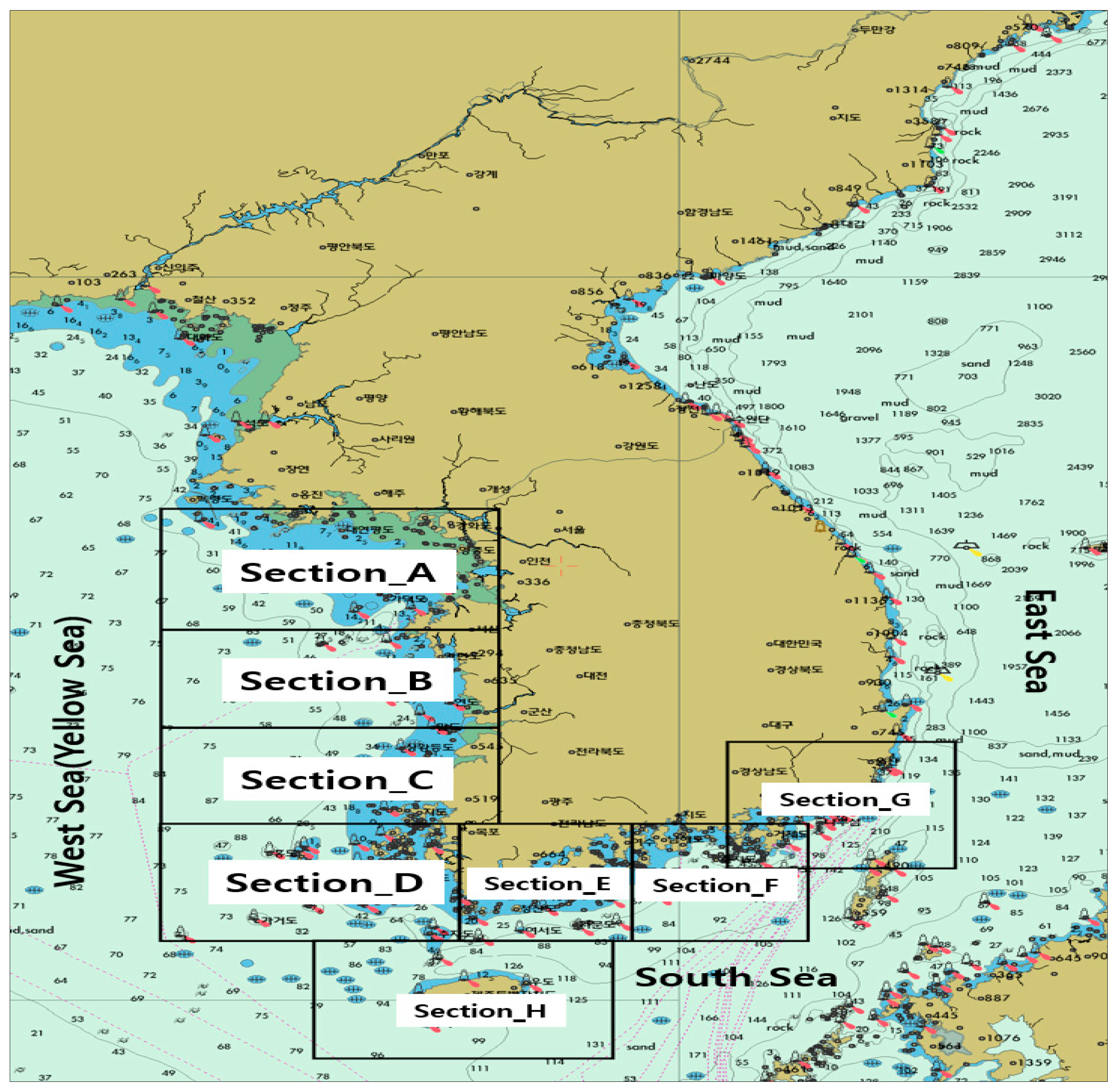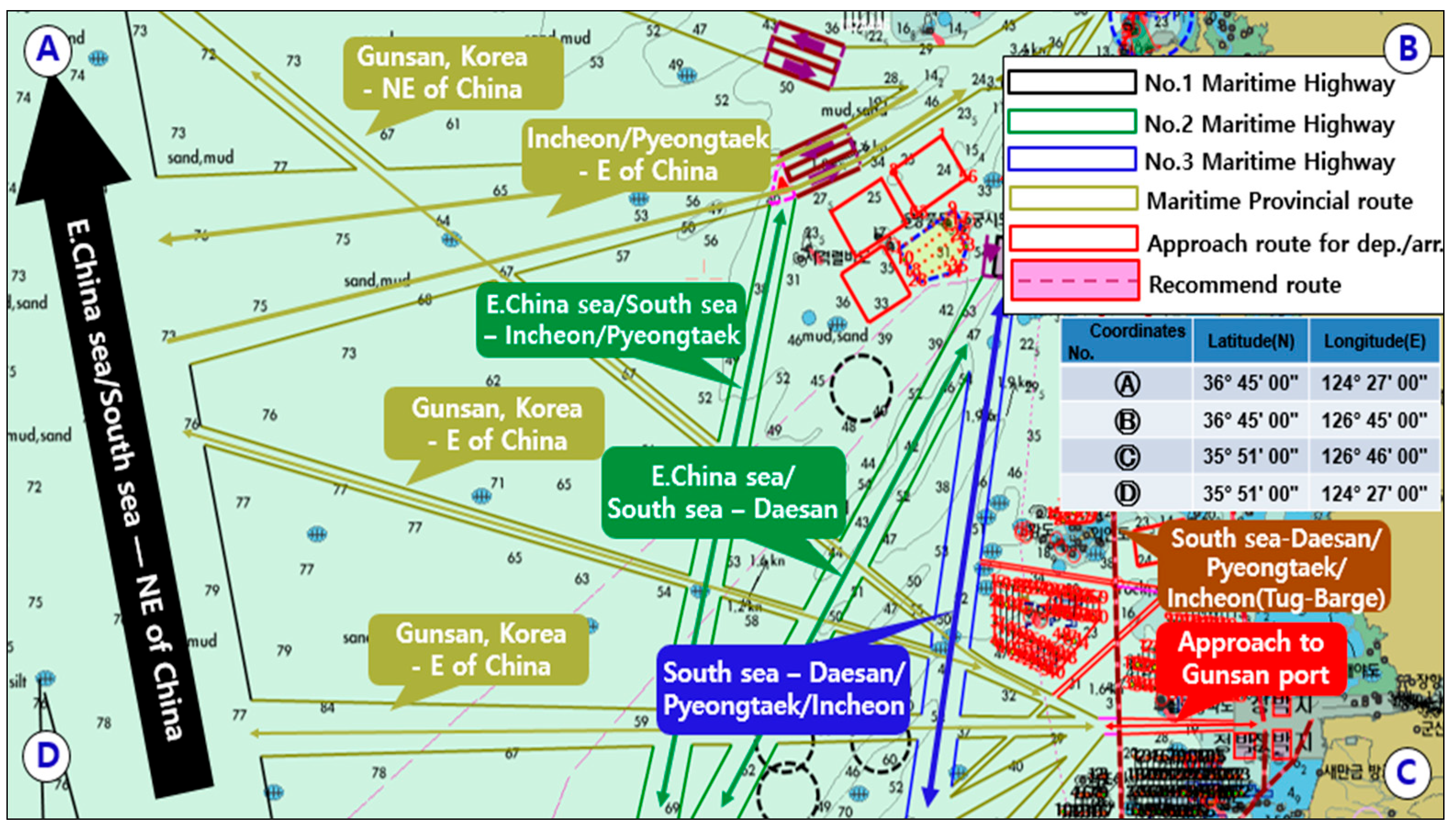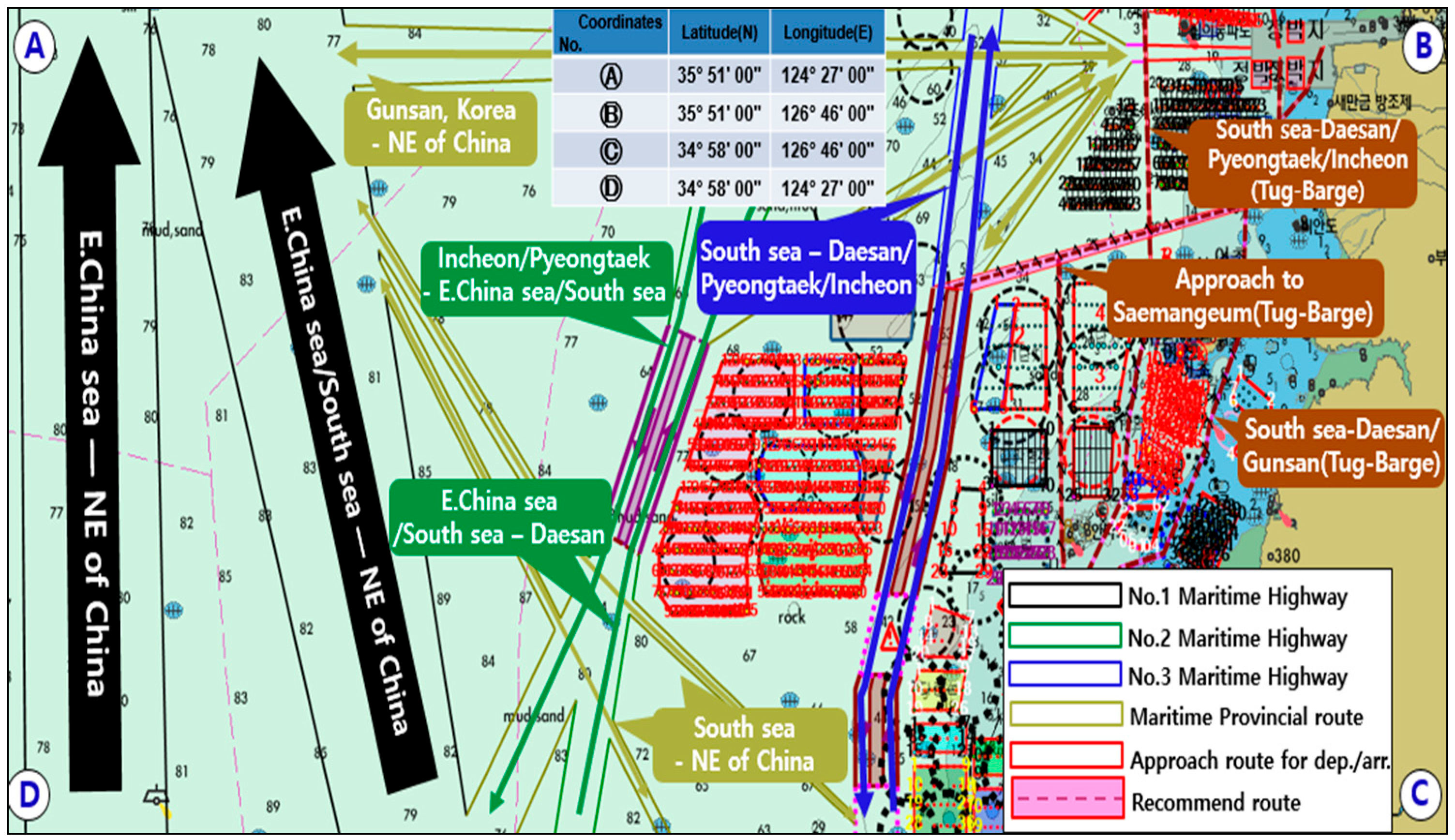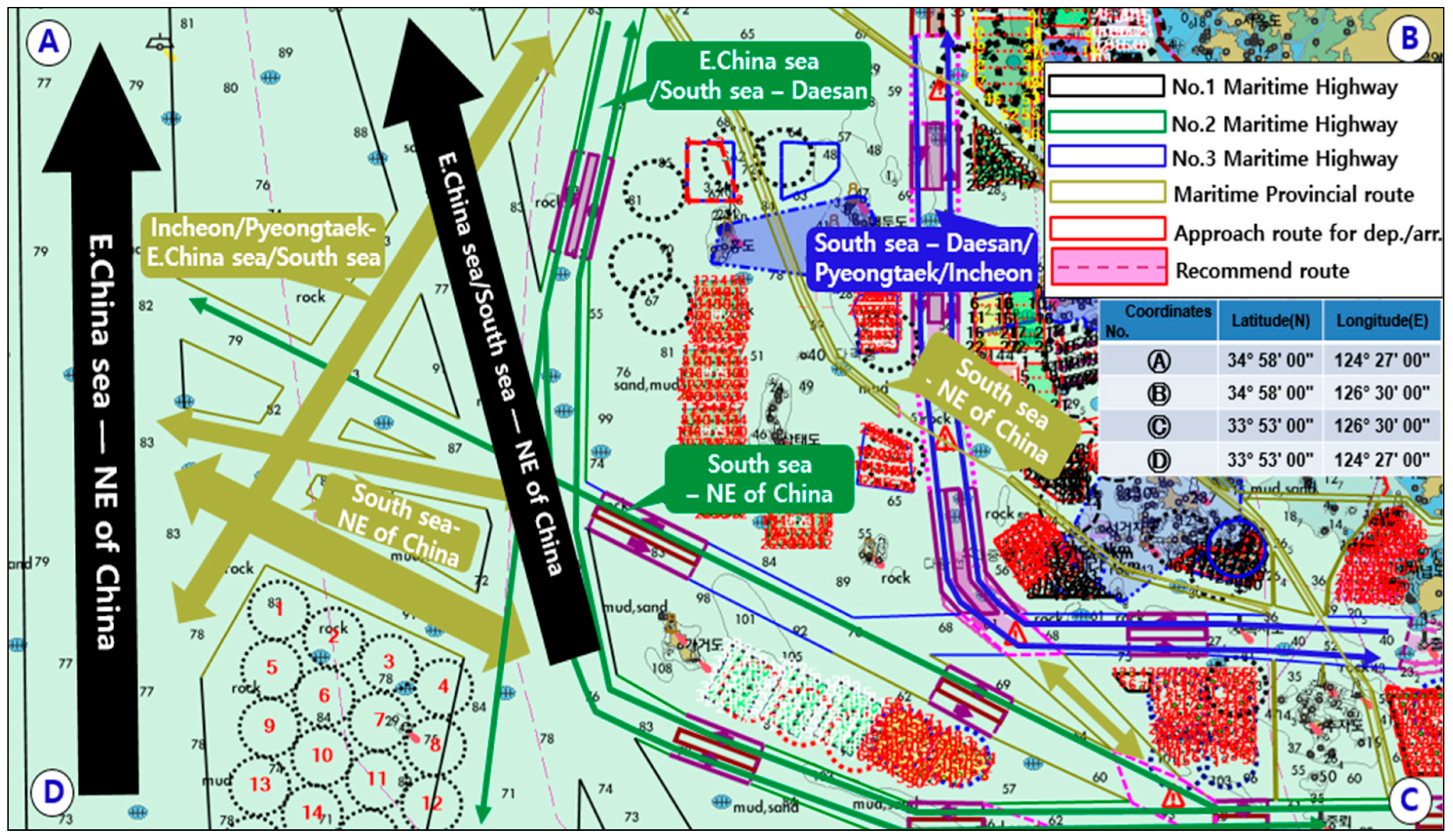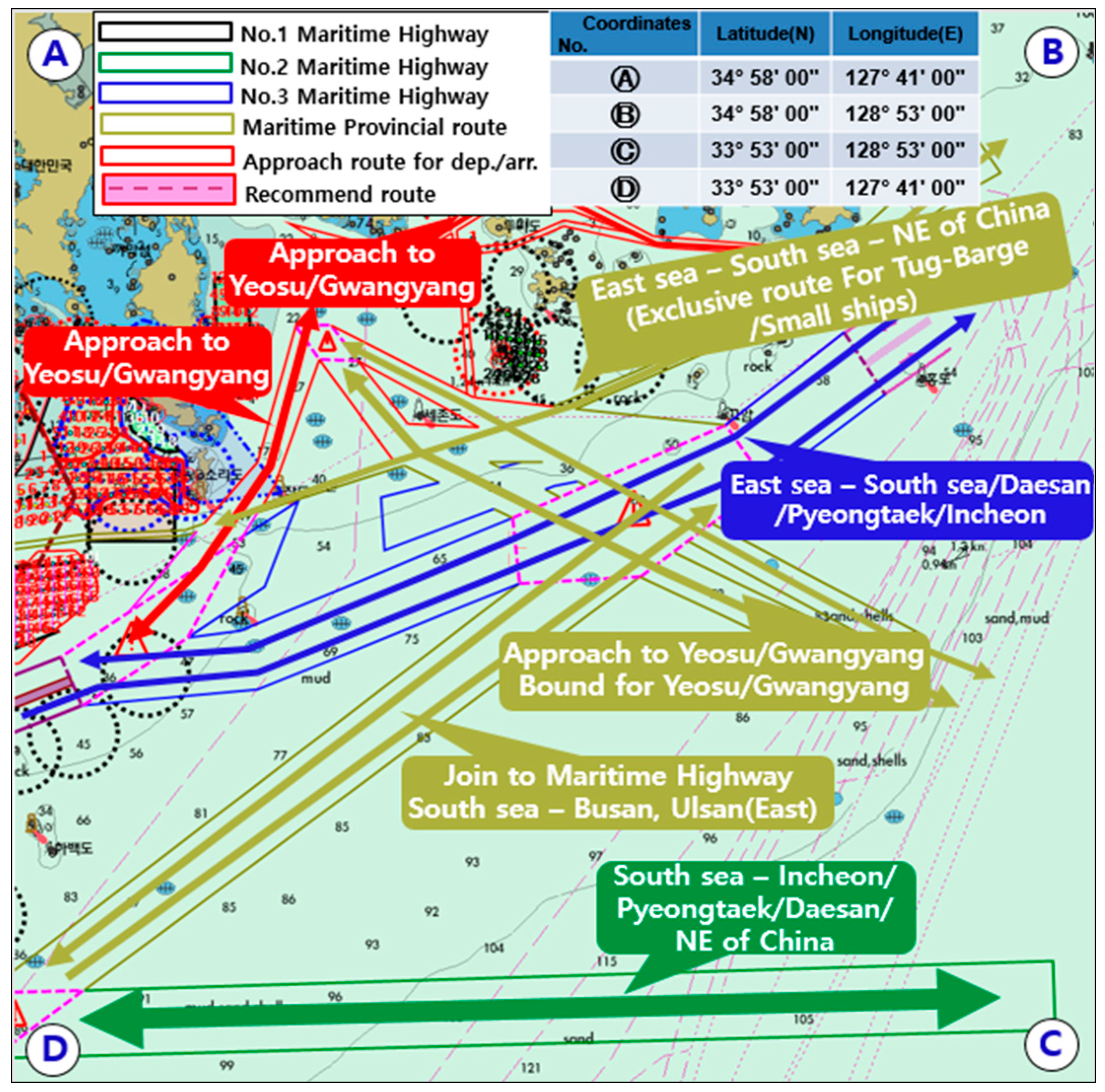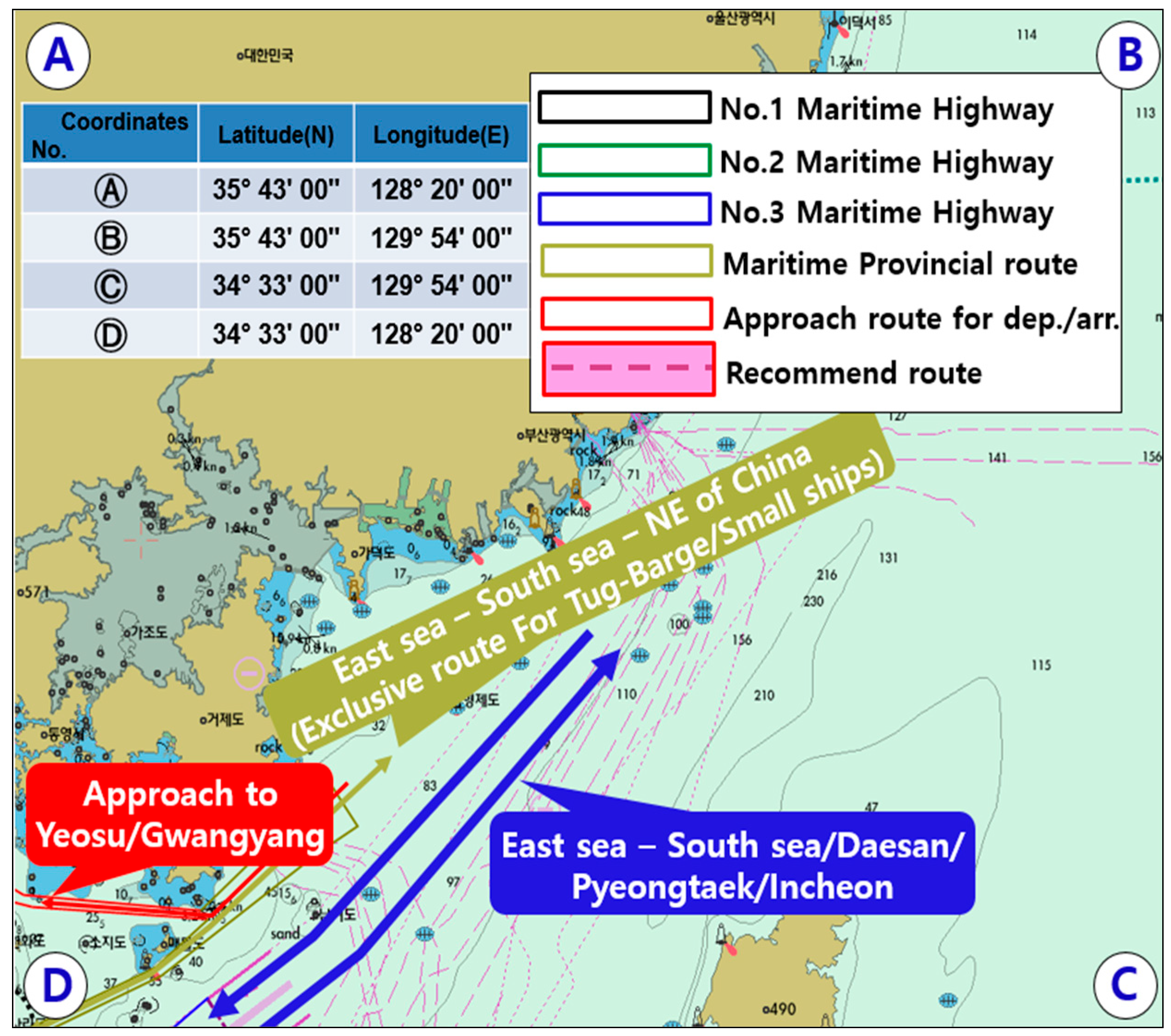1. Introduction
The increasing global demand for energy and the depletion of energy resources highlight the undeniable need for sustainable and stable power generation. Existing energy resources are not only finite but also contribute to environmental challenges such as global warming, which causes sea levels to rise. Consequently, a significant shift toward eco-friendly policies is being implemented to address these environmental issues. These concerns have been persistently raised since the late 20th century, leading to the formulation and adoption of climate agreements, including the Kyoto Protocol in 1997 and the Paris Agreement, which came into force in 2016, building upon and updating the goals of the former [
1]. From the past to the present, various activities have been carried out regarding the development of renewable energy and the formulation of related policies [
2,
3]. In this context, the South Korean government has announced numerous policies and initiatives, including the Renewable Energy 3020 Plan and the 2050 Carbon Neutrality Strategy, to promote the generation of power through renewable energy. Among various renewable energy sources, offshore utilization presents significant advantages, particularly due to South Korea’s geographical characteristics, as the country is surrounded by the sea on three sides, making offshore energy resources highly valuable. Offshore areas experience stronger winds than onshore locations, enhancing the efficiency of wind power generation. Additionally, offshore wind farms (OWFs) offer superior advantages in terms of minimal noise disturbance and spatial utilization. Offshore wind power generation can be categorized into two types: fixed-bottom and floating systems. Fixed-bottom offshore wind turbines are securely anchored to the seabed, whereas floating offshore wind turbines are stabilized by anchors on the seabed and connected to turbine columns and platforms using anchor chains. Fixed-bottom offshore wind power has already established a dominant position in the global offshore wind market, which is led by Northern European countries, particularly in the North Sea region. As of 2022, fixed-bottom OWFs accounted for approximately 45% of global offshore wind energy production [
4]. In Asia, China is leading in offshore wind power development, followed by Japan, Taiwan, Vietnam, and South Korea, all of which are actively promoting the expansion of wind energy. Depending on the water depth characteristics, a strategic combination of fixed-bottom and floating OWFs is expected to be implemented. Among these, fixed-bottom wind power is typically developed in shallow waters, allowing for installation in coastal areas. This presents advantages such as lower construction and maintenance costs, making it a promising option for future development. However, the increasing number of OWFs may pose risks to the safe navigation of vessels. In particular, coastal waters serve as entry routes for ships approaching ports, necessitating the secure establishment of maritime traffic routes. Northern European countries bordering the North Sea such as the United Kingdom, the Netherlands, Belgium, and Germany are recognized as global leaders in the development and operation of offshore wind farms. These nations have designated and operate shipping lanes and traffic separation schemes (TSSs) in waters adjacent to offshore wind farm sites [
5,
6]. The implementation of such navigational measures is particularly critical in areas with high traffic density and frequent crossing routes, as they significantly enhance maritime safety and should be considered an essential component of offshore wind farm development. The selection of development sites for offshore wind farms involves multiple factors, including maritime traffic. Accordingly, in this context, the following previous studies were reviewed in relation to the site selection process for offshore wind farm development.
Sanchez-Lozano et al. (2014) identified the optimal site for power generation facilities in the Murcia region of Spain by first excluding areas unsuitable for development due to legal restrictions and specific factors related to offshore wind power. They employed a geographic information system (GIS)-based ELECTRE-TRI method for this analysis [
7]. Kim et al. (2022) utilized GIS techniques to determine the optimal location for OWFs from the perspective of mitigating coastal disaster risks. The authors comprehensively analyzed seismic activity and typhoon trajectories in the southwestern sea region of South Korea [
8]. Konstantinos et al. (2019) proposed a methodology that integrates the analytical hierarchy process (AHP), a multi-criteria decision-making (MCDM) approach, with GIS to determine the most suitable location for OWF development in the Macedonia and Thrace regions of Greece, which are located in the Mediterranean Sea. To rank the identified locations based on installation suitability, they applied the Technique for Order Preference by Similarity to Ideal Solution (TOPSIS) [
9]. Ayodele et al. (2018) proposed a GIS-based Interval Type-2 Fuzzy AHP model to determine suitable locations for OWFs in Nigerian waters. This model was designed to characterize uncertainties, ambiguities, and inconsistencies inherent in the decision-making process [
10]. Xu et al. (2020) developed a site selection methodology for OWFs in the Wafangdian region of China by integrating the GIS-based interval analytic hierarchy process (IAHP) with the stochastic VIKOR method [
11]. Wu et al. (2018) constructed a decision-making framework for OWF site selection by employing ELECTRE-III (Elimination et Choix Traduisant La Réalité-III) in an intuitionistic fuzzy environment. This approach aimed to address information loss in MCDM methodologies and interaction issues within fuzzy environments [
12]. Lee et al. (2020) conducted a spatial analysis using vessel automatic identification system (AIS) data to identify and evaluate the influencing factors for optimal offshore wind farm site selection [
13]. Lee et al. (2018) established appropriate criteria for maritime traffic survey methods and assessments that can evaluate the marine space, such as offshore wind farms, and investigated ways to process these systematically [
14]. Kwon et al. (2018) analyzed the regulations on vessel traffic and fishing activities in major OWFs in Northern European countries and suggested considerations for establishing vessel traffic and fishing activity standards when developing OWFs in South Korean waters. However, the detailed methodology was left as a subject for future research [
15].
Meanwhile, the following previous studies were reviewed regarding the assurance of maritime traffic safety in relation to the development of offshore wind farms and the extraction of navigational routes using vessel AIS data. Yang (2014) analyzed the traffic volume and maritime flow patterns of vessels operating in the waters surrounding the Daegyeong offshore wind farm to be installed southwest of Jeju island, Republic of Korea, based on the designation of reasonable alternative shipping routes, and proposed measures for ensuring safe vessel operations [
16]. Qing et al. (2020) proposed a framework to assess the impact of offshore wind farms on maritime traffic flow, based on AIS data collected before and after the installation of the wind farms [
17]. In addition, Rawson and Rogers (2015) presented a comparative analysis of changes in vessel traffic volume before and after the construction of offshore wind farms in the Thames Estuary near London, United Kingdom [
18]. Tsai and Lin (2021) conducted a collision risk analysis for waters surrounding offshore wind farms to be developed in the western area of Taiwan using the fault tree analysis (FTA) method. Based on the analysis results, they proposed several countermeasures to enhance navigational safety, including the integration of vessel traffic service and management systems, the provision of remote pilotage service, and the deployment of salvage vessels [
19]. Son and Cho (2024) conducted a comprehensive analysis of maritime routes in the vicinity of a proposed floating offshore wind farm along the eastern coast of the Republic of Korea. By incorporating a wide range of vessel sizes and configurations, they developed a simulation model capable of representing maritime traffic distribution. Utilizing this model, their study evaluated the probabilities and risks of collisions both between vessels and between vessels and the offshore wind farm [
20]. Yan et al. (2023) developed a qualitative and quantitative accident analysis model, CAST-CN, by integrating Casual Analysis based on System Theory (CAST) and a complex network (CN) and applied it to analyze a case of collision between a vessel and a wind turbine in offshore wind farm waters [
21]. Gao et al. (2022) developed a probabilistic safety distance model between vessel routes and offshore wind farm boundaries, taking into account actual meteorological and hydrographic conditions, vessel drift distances, and acceptable collision probabilities. The model was constructed based on the assumption of a normal distribution of vessel trajectories and incorporated reliability analysis to reflect the statistical tendencies and uncertainties inherent in maritime navigation [
22]. Rawson and Brito conducted a maritime traffic risk assessment regarding the potential risks to ship operations caused by the development of offshore wind farms. Consequently, they identified the methodological limitations inherent in the process and proposed directions to enhance the accuracy of the assessments [
23]. Marcjan and Kotkowska monitored maritime traffic in the designated area for an offshore wind farm planned along the Polish coast in order to identify and analyze risks associated with the development of new offshore renewable energy projects [
24]. Mehdi et al. (2019) identified five categories of risks associated with the presence of offshore wind farms. Among these, the risk posed by offshore wind farms to vessel navigation was analyzed to be the most significant. Accordingly, the study recommended the development of appropriate safety measures to address this issue in the future [
25]. Furthermore, Al-Quhali et al. (2018) presented a case in which the rerouting of a passenger ferry due to the construction of an offshore wind farm led to potential encounters with vessels approaching from other directions, thereby creating navigational confusion. The study highlighted that, in such situations, existing maritime spatial planning (MSP) frameworks have not effectively incorporated VTS data or existing guidelines, indicating a gap in their practical application [
26]. Moreover, Bai et al. (2022) employed the DBSCAN algorithm to cluster meaningful data based on vessel AIS trajectory data and subsequently extracted navigational routes from the clustered results [
27].
While the aforementioned studies have provided methodologies and models for selecting optimal sites for OWFs, they have not addressed the topic of securing maritime traffic routes based on vessel safety considerations in site selection criteria. Although numerous studies have been conducted using quantitative evaluation methods to ensure navigational safety such as risk assessments and collision probability analysis between offshore wind farms and vessels, evaluations of impacts on maritime traffic flow, and route extraction based on AIS trajectory data, research explicitly addressing the designation of essential and practical navigation routes in the vicinity of offshore wind farm installations, along with a rationale supporting such routes, remains insufficient. Vessels navigating the sea have established fixed or customary passage routes from the past to the present, regardless of OWF developments. Therefore, to prevent disruptions to maritime traffic flow, distance criteria must be applied to ensure vessel safety by maintaining an appropriate separation from OWFs. This study proposes an alternative maritime traffic route to accommodate OWF development in South Korean waters, which may encroach upon existing customary navigation routes. The proposed maritime traffic route applies the “Maritime route–OWF clearance rule” specified in maritime traffic safety assessments to ensure the secure passage of vessels. Additionally, the implementation of a traffic separation scheme (TSS) is intended to enhance the safety of both vessels and offshore structures. The designated maritime traffic route and the alternative navigation routes incorporating the TSS are expected to mitigate the risk of accidents caused by unregulated vessel movement, particularly in crossing traffic areas of customary navigation routes. By ensuring that vessels adhere to the designated routes, overall maritime safety can be significantly improved.
2. A Review Based on the Application of Domestic and International Regulations and Guidelines on OWFs and Vessel Traffic Safety
This chapter reviews domestic (Republic of Korea) and international regulations and guidelines concerning navigational safety between offshore wind farms and vessels. Based on this review, appropriate regulatory frameworks are adopted and applied as part of this study’s methodology. The objective is to ensure safe vessel navigation by maintaining a secure separation distance from offshore wind farm structures, which may pose potential hazards to maritime traffic.
To begin with, the Maritime Traffic Safety Act of South Korea regulates the safety management system for the safe operation of vessels, covering aspects such as waterway safety management, maritime traffic safety management, the safety management of vessels and facilities, and vessel navigation. This act aims to eliminate all risks and obstacles related to vessel navigation, thereby contributing to maritime safety and the smooth flow of vessel traffic. According to Article 13 (Maritime Traffic Safety Assessment) of the Maritime Traffic Safety Act [
28], a maritime traffic safety assessment must be conducted for facilities built at sea, in accordance with the safety assessment standards prescribed by the Ministry of Oceans and Fisheries. Furthermore, the implementation guidelines for the maritime traffic safety assessment (Ministry of Oceans and Fisheries Announcement No. 2022-162) outline technical standards for safety assessment items Appendix 3 in [
29]. The maritime route–OWF clearance rule specifies that, to ensure safe vessel operation, the clearance between the maritime route and OWFs must adhere to the guidelines set by the Permanent International Association of Navigation Congresses (PIANC), which recommends a distance of six times the length of the vessel plus a safety zone of 500 m. Additionally, if the wind farm is located on the starboard side, a 0.3 nautical mile buffer is also required.
The PIANC, which comprises approximately 45 member countries worldwide has eight specialized committees, one of which is the Maritime Navigation Commission. In 2018, the commission published guidelines on the mutual impacts between shipping lanes and OWFs [
30]. These guidelines outline six key factors that must be considered when establishing a safe distance between vessels and OWFs: (1) the type of vessel, (2) maritime traffic patterns and traffic volume, (3) physical conditions such as water depth, (4) maritime and weather conditions, (5) piloting conditions, and (6) towing conditions. Based on these six factors, the guidelines estimate the safe distance between vessels and OWFs, which should be six times the length of the vessel plus a 500 m safety zone. Additionally, when the wind farm is located on the starboard side, a 0.3 nautical mile buffer is applied. The primary legal framework for these considerations is the International Regulations for Preventing Collisions at Sea or Collision Regulations (COLREGs), specifically Article 8, “Action to avoid collision” [
31], which outlines the duties of give-way and stand-on vessels and requires a full rudder maneuver to avoid collision.
The United Nations Convention on the Law of the Sea (UNCLOS), Article 60 (Artificial Islands, Installations, and Structures in the Exclusive Economic Zone) [
32], stipulates the establishment of a safety zone around artificial islands, facilities, and structures located in the sea to ensure the safety of vessels navigating in the area. The size of this safety zone is measured from the outermost points of the structure and should not exceed 500 m. While OWFs are not explicitly mentioned, wind turbines would fall under the category of offshore structures and would therefore be subject to these regulations.
In the waters near Japan, the depth increases rapidly beyond a certain distance from the coastline, which is why OWFs are typically developed in areas close to ports. According to the Ministry of Land, Infrastructure, Transport and Tourism (MLIT) guidelines (2015) [
33], safety distance guidelines for OWFs and vessels in these areas have been established. The larger of the following two conditions should be applied: the distance that is unaffected by the wake (2D) and the safety distance (
Hf) required in the event of a turbine collapse.
A comparison and analysis of domestic and foreign guidelines reveal the following: the 500 m safety zone specified by the UNCLOS has been incorporated into the PIANC guidelines, which have subsequently been applied in the Maritime Traffic Safety Act’s implementation guidelines for maritime traffic safety assessments in South Korea. Since this study focuses on OWFs to be developed in South Korean waters, applying the standards outlined in the implementation guidelines based on the Maritime Traffic Safety Act is appropriate.
5. Suggestion of an Alternative Passage at the OWF Area
OWFs are planned for development in various areas, including the coastal waters and distant seas of South Korea. Consequently, the conventional trade routes between major ports, port entrances and exits, and offshore passage areas will no longer be fully usable. Therefore, the existing customary navigation routes have been relocated around the areas where wind farms are planned for development and the waters between the wind farms. The relocated alternative navigation routes apply the standard of “6 L + 0.3 NM + 500 m” when the wind farm is located on the starboard side, as outlined in the PIANC Guidelines. Vessel navigation follows the principle of port-to-port navigation, including TSS and designated crossing routes, and ships are always expected to approach wind farms from the starboard side. Based on this principle, an appropriate distance was maintained, and the navigation routes were arranged accordingly.
Figure 12 demonstrates the alternative navigation routes due to the development of OWFs across South Korea.
As described in
Section 4, maritime traffic routes can be broadly categorized into four types: the marine high-speed shipping route, which is the major traffic route connecting key ports or major ports to international ports; the marine feeder shipping route, which connects marine high-speed shipping routes; the port entry and exit approach route; and the recommended route. As defined and described in
Section 4, each proposed traffic route is categorized according to its name and function, based on the geographical characteristics of the sea area and the interconnectivity between navigational routes. This approach parallels the concept of road traffic systems for automobiles in land-based transportation. The offshore areas and coastal waters adjacent to ports exhibit clear differences in vessel speed depending on the readiness of the main engine, which is influenced by traffic density and the frequency of multi-ship encounters depending on their proximity to ports. Considering these constraints, the function assigned to each route reflects the operational status of vessels. Therefore, vessel navigation within the proposed routes defined according to the functions and characteristics outlined in
Section 4 is expected to ensure safe passage in sea areas developed for offshore wind farms.
5.1. An Alternative Passage and the Locations of OWFs for Each Section
5.1.1. Section A
In Section A, a recommended route was established in the waters between the OWFs planned on the Incheon–Baengnyeong Island route, on both the left and right sides of the route. This area is primarily used by relatively smaller vessels such as fast ferries, so instead of setting a fixed width for the route, a recommended route was proposed to allow exclusive use. Additionally, for large fast ferries or cargo vessels operating between Incheon or Pyeongtaek ports and northeastern China, the maritime route–OWF clearance rule was applied to the south side of the development area to ensure appropriate clearance before setting the marine feeder shipping route. This marine feeder shipping route uses TSS to ensure safe passage and was configured to merge with the first marine high-speed shipping route.
Figure 13 demonstrates the layout of OWFs and surrounding alternative navigation routes for Section A.
5.1.2. Section B
In Section B, a marine feeder shipping route was proposed to avoid the OWFs to be developed on the western side of Taean Port, connecting the northern route from Incheon and Pyeongtaek ports to the eastern Chinese ports. A similar route was also established on the southern side of the OWFs to be developed northwest of Gunsan Port, heading toward the eastern and northeastern Chinese ports. Additionally, the existing Maemul–Sudo TSS was extended to establish the third marine high-speed shipping route in a straight line, enabling vessels to head toward Incheon, Pyeongtaek, and Daesan ports. Furthermore, a second marine high-speed shipping route was established in a straight line on the western side of the third route, allowing vessels from the East China Sea and southern coastal ports to operate toward Daesan, Incheon, and Pyeongtaek ports. Finally, a recommended route was established to avoid the OWFs to be developed southeast of Gunsan Port, providing a route for small vessels, such as fast ferries, in the coastal navigation area.
Figure 14 illustrates the layout of the OWFs and surrounding alternative navigation routes for Section B.
5.1.3. Section C
In Section C, due to the planned development of a large-scale OWF south of Gunsan Port, a third marine high-speed shipping route was established by extending the existing Maemul–Sudo TSS westward, allowing navigation toward Daesan, Pyeongtaek, and Incheon ports. As outlined in Section B, a second marine high-speed shipping route was configured to the west of the third marine highway, facilitating navigation from the East China Sea and southern coastal ports to Daesan, Pyeongtaek, and Incheon ports. A marine feeder shipping route was established between the second and third marine high-speed shipping routes to facilitate navigation from the southern coastal regions to northeastern Chinese ports. Additionally, at the terminus of the marine feeder shipping route, provisions were made to integrate it with the first marine high-speed shipping route, which operates from the East China Sea and southern coastal ports to northeastern Chinese ports. Finally, a recommended route was designated within the coastal traffic zone to the east of the third marine high-speed shipping route, enabling small vessels, such as tender boats, to navigate the waterway between the large-scale OWFs.
Figure 15 illustrates the configuration of the OWFs and the surrounding alternative navigation routes for Section C.
5.1.4. Section D
As in Section C, a large-scale OWF is planned for development from the southern part of Gunsan Port to the southwestern part of Jindo. Consequently, a third marine high-speed shipping route was established by extending the existing Maemul–Sudo TSS westward, enabling navigation toward Daesan, Pyeongtaek, and Incheon ports. Additionally, a second marine high-speed shipping route was configured south of the third marine high-speed shipping route, creating a passage to northeastern China from the southern coast, as well as a route to Daesan Port on the west coast. A marine feeder shipping route was established between the second and third marine high-speed shipping routes, and the terminus of the second marine high-speed shipping route on the western side was connected to the first marine high-speed shipping route, which leads to northeastern Chinese ports. To the east of the third marine high-speed shipping route, a feeder shipping route was designated within the waters between the OWFs, allowing small vessels, such as tender boats, to utilize the coastal traffic zones.
Figure 16 illustrates the configuration of OWFs and the surrounding alternative navigation routes for Section D.
5.1.5. Section E
In Section E, a large-scale OWF is planned for development on the east and west sides of Wando Port. Consequently, a marine feeder shipping route was established by extending the existing east–west recommended route to the south. Additionally, dedicated routes for passenger vessels operating regularly between Goheung and Yeosu Dolsando were established to avoid wind farms. To the south of the east–west recommended route, a large-scale OWF is expected to be developed. The “Maritime route-OWFs clearance rule” was applied, and the existing Yeokman-do–Bogildo TSS was extended to establish the third marine high-speed shipping route. To the south of the third marine high-speed shipping route, the second marine high-speed shipping route was set, and a marine feeder shipping route connecting the two high-speed routes was established, allowing navigation toward Yeosu, Busan, and Ulsan to the northeast and Daesan, Pyeongtaek, and Incheon to the northwest.
Figure 17 illustrates the configuration of the OWFs and the surrounding alternative navigation routes for Section E.
5.1.6. Section F
In Section F, there is considerable traffic volume at the entry points to Yeosu and Gwangyang ports, necessitating the establishment of entry routes and other related navigation paths. The existing Hongdo TSS was connected to the Yeokman-do TSS and was designated as a general route, and the area where the marine feeder shipping route connects the second and third marine high-speed shipping routes was designated as a cautionary area. Furthermore, to ensure the safe passage of smaller vessels, such as pilot boats, the marine feeder shipping route was extended, and a cautionary area was established at the confluence of the routes entering and exiting Yeosu and Gwangyang ports.
Figure 18 illustrates the configuration of the OWFs and the surrounding alternative navigation routes for Section F.
5.1.7. Section G
In Section G, as mentioned in Section F, the marine feeder shipping route was extended and established to ensure the safe passage of smaller vessels, such as pilot boats. Additionally, an approach route was set up to avoid the OWFs for vessels entering Yeosu and Gwangyang ports. Currently, there are no plans for OWF development to the northeast of the Hongdo TSS; thus, the marine high-speed shipping routes were not connected.
Figure 19 illustrates the configuration of the OWFs and the surrounding alternative navigation routes for Section G.
5.1.8. Section H
In Section H, the marine feeder shipping routes are divided into five segments, passing through or merging with the second marine high-speed shipping route from Jeju Port to Incheon, Pyeongtaek, Daesan, and ports in northeastern China, as well as to Yeosu-Gwangyang, Busan, and Ulsan. As demonstrated in
Figure 19, the marine feeder shipping routes are set in a straight-line configuration to follow the shortest possible distance. Should OWFs be developed in this area in the future, adjustments will be necessary.
Figure 20 illustrates the arrangement of the OWFs and the surrounding alternative navigation routes for Section H.
5.2. Discussion
In the maritime areas designated for offshore wind farm development, wind turbines may pose navigational hazards to the safe operation of vessels. Therefore, this study aimed to secure safe separation distances between ships and offshore wind turbines. To achieve this, relevant domestic and international regulations and guidelines were reviewed and compared, with the implementation standards based on the Korean Maritime Traffic Safety Act applied. After securing safe separation distances, this study then sought to establish suitable route widths to maintain existing vessel traffic flow. For this purpose, various factors specified in the PIANC guidelines were utilized. Furthermore, the maritime routes were categorized into maritime highways, maritime provincial routes, approach routes for departure/arrival, and recommended routes, depending on their function in connecting major trading ports and the operational status of the main engine (M/E).
This study aimed to ensure the safe navigation of vessels by proposing alternative routes in adjacent waters in preparation for the potential development of large-scale offshore wind farms in designated maritime zones. By simultaneously applying the Guidelines for Distance between Maritime Traffic Routes and Offshore Wind Farms and the Standards for Route Design, this research established navigation routes and traffic separation schemes (TSSs) in areas adjacent to offshore wind farm zones. This integrated approach distinguishes this study from previous research in the field. Previous studies have primarily focused on determining the optimal siting of offshore wind farms using various methodologies and have employed quantitative evaluation techniques such as risk assessments of vessel navigation and collision probability analyses. However, they have generally not proposed practical safety measures, such as the designation of alternative routes that ensure the continuity of existing maritime traffic flows. In contrast, while this study does not incorporate advanced quantitative analytical methods such as clustering-based algorithms widely used in recent research, it aims to address practical aspects of navigational safety. Nonetheless, the implementation guidelines based on the Maritime Traffic Safety Act, which were applied to determine safe separation distances between offshore wind farms and vessels, have inherent limitations. These guidelines do not sufficiently account for variations in lateral dimensions according to ship type and main engine (M/E) status at specific locations, nor do they reflect the influence of environmental forces or ship encounter scenarios on evasive maneuvering areas. Moreover, the PIANC Rule adopted as the methodological basis for route width design uniformly categorizes vessel maneuverability (good, moderate, and poor) by ship type, which may not adequately represent the full diversity of vessels in practice. Therefore, further in-depth studies are necessary to address these limitations. Furthermore, although this study proposed alternative navigation routes aimed at maintaining existing traffic flows following the development of offshore wind farms, it has a limitation in that a clear validation framework, such as simulation-based verification, has not been presented. In the future, detailed studies are required to verify the safety of navigation in the proposed alternative routes developed in response to offshore wind farm projects in Korean waters. This includes applying actual environmental force conditions of the sea area and deploying representative vessels within ship maneuvering simulations to assess the feasibility of safe navigation.
6. Conclusions
As OWFs are scheduled to be developed in the waters of the Republic of Korea in the future, vessels that currently use customary navigation routes will face reduced efficiency, as they will need to detour around wind turbine structures. Additionally, since these routes have not been designated, safety cannot be ensured. Therefore, in this study, alternative navigation routes were proposed to replace the existing customary routes, considering efficiency and ensuring that the alternative routes align with the current traffic flow, without being too far apart. The established routes reflect the clearance rule of 6 L + 0.3 NM + 500 m, as specified in the “Maritime route-OWFs clearance rule.”
The established navigation routes are broadly categorized into four types. The first is the marine high-speed shipping routes, which are the main navigation routes connecting major trade ports within the Republic of Korea or leading to key overseas trade ports. The second is the marine feeder shipping route, which connects the traffic flow of vessels operating in coastal waters or between marine high-speed shipping routes. The third is the port entry and exit approach route, which refers to the approach sections for vessels entering and exiting ports. Finally, the fourth is the recommended route, designed to ensure safe navigation for small vessels, such as tenders, that operate in coastal traffic lanes rather than in deep seas due to the influence of waves. Each route can be used by vessels traveling in different directions, but they are categorized into TSS and recommended routes, with traffic flows that are either distinguishable or undistinguishable in the case of generally designated routes. In response to the significant shift in energy policies, many countries surrounding the oceans, including the Republic of Korea, will develop large-scale OWFs to take advantage of marine resources. Accordingly, this study proposed alternative navigation routes to ensure the safe navigation of numerous vessels operating in sea areas designated for offshore wind farm development. The designation of routes, reflecting the current traffic flow, will help prevent marine accidents through the application of international and domestic clearance rules and will enable more efficient monitoring to prevent safety incidents. However, this study does not incorporate advanced analytical methodologies commonly employed by many researchers in the field of maritime navigation. Moreover, the implementation guidelines based on the Maritime Traffic Safety Act, which were used to determine safe separation distances between offshore wind farms and vessels, have clear limitations. These guidelines do not account for critical factors such as vessel-specific maneuverability, variations in lateral clearance according to the operational status of main engines (M/Es), or the influence of external environmental forces. Furthermore, this study has a limitation in that it does not present a quantitative validation framework such as simulation-based analysis for the proposed alternative navigation routes. To address this, future research will aim to establish a systematic and comprehensive safe separation distance between offshore wind farms and vessels by considering various ship types, turning radii reflecting the characteristics of main engines, and the operational status of main engines (M/Es) depending on the siting characteristics of offshore wind farms. In addition, the verification of navigational safety will be conducted through ship maneuvering simulations by utilizing real-world environmental forces and a structured database that includes information on representative vessels and offshore wind farm developments.
